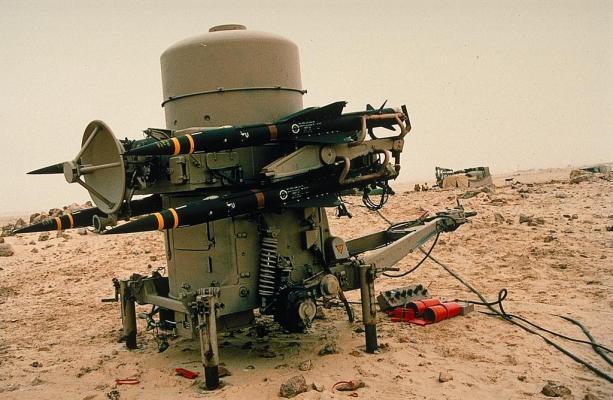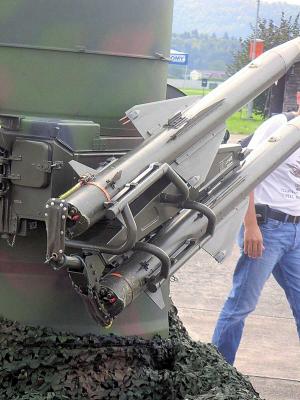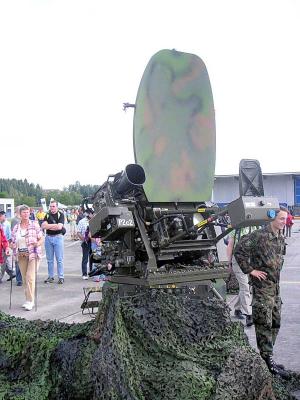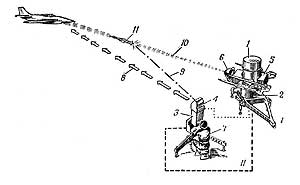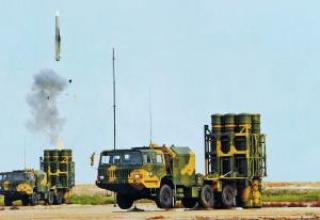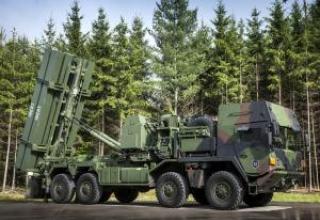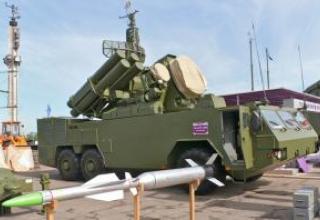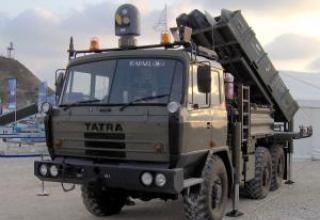Short range anti-aircraft missile system "Rapier" is designed to directly cover troops in the forward zone from the enemy's air attack means operating at low altitudes. It began to be created by the company "Matra BAe Dynamics" in the early 60's, commissioned by the British Department of Defense. It was intended to create a complex with a short reaction time, the ability to quickly take up combat positions, with a compact layout of equipment, low mass-profile characteristics, high firing speed and the probability of hitting the target with a single missile.
The first prototypes of the SAM system were manufactured in 1967. The British Army (Army) received the complex since 1972, in 1974 it was adopted by the Royal Air Force to provide air defense of airfields. In the air defense system of the Army the "Rapier" complex is used in the second and third lines of air defense. The first line consists of man-portable air defense systems such as "Javelin" and "Starburst", which cover the "dead" zone of the Rapier complex. The second line of air defense is created by a self-propelled "Rapier-TLRV", and the third - by a towed version of the complex "Rapier".
The "Rapier" complex was constantly upgraded, its tactical and technical characteristics were improved, and the range of targets (for example, cruise missiles) was expanded. In general, it is believed that the degree of automation of combat work of the complex has increased by 50% by the end of 1987. The modernization program concerned both the systems in service and those in serial production. By 1997 there were more than 700 launchers of towed and self-propelled versions of the Rapier system and 25,000 missiles of various modifications. In addition, some 12,000 missiles have been used in tests, exercises and combat operations during this period. The basic Rapier system with the Blindfire radar has the Field Standard A (FSA) cipher. In 1979-1980 "Field Standard Bl" (FSB1) followed: the main modernization element was that the target detection radar was automatically switched off when an anti-radar missile was detected. In addition, the identification system was improved and the system became more interference-proof under radio interfering conditions. In 1985, the FSB2 optronic system was tested by the army under the name "Rapier Darkfire". For the FSB2 the optical system was equipped with a thermal imaging device, an upgraded launcher with 6 missiles (see photo) and an improved flat grid of the pulse Doppler surveillance radar. In addition, a TCS (Console Tactical Control System) remote control unit was introduced for the fire commander. Four batteries of "Rapier" complexes of FSB2 standard were produced. In 1989 the development of "Rapier-Laserfire" complex with laser device for automatic tracking of targets was completed.
At present the production of "Rapier" complex of FSA, FSB1, FSB2 modifications is completed and "Rapier-2000" complex (FSC) replaced it.
Export deliveries of "Rapier" SAMs were made to Australia, Oman, Qatar, Brunei, Switzerland, Iran, Turkey, Zambia. The US Air Force purchased 32 complexes for the air defense system of the US air bases in the UK.
Composition:
The main combat vehicles of "Rapier" SAM system are presented as several units:
- launcher on a single axle semi-trailer towed by a cross-country vehicle,
- an optical tracking device with a control panel and an infrared direction finder for the missile's tracer,
- power source (electric generator with gasoline engine), which is mounted on a separate semi-trailer.
The main component of the towed complex "Rapier" is the launcher (PU) (see photo1, photo2, photo3, photo4). The system of detection and target designation of the complex is mounted on the PU and includes: a surveillance radar of target detection, identification system "own-user", a station for transmission of radio commands pointing on board the missile and a counting and solving device. The surveillance radar is located in the center of the PU, the radar antenna is placed under the radio cover in the upper part of the PU and rotates at a speed of 1 rev / s. The surveillance radar is capable of detecting low-flying targets against the background of reflections of the signal from the ground surface at ranges over 15 km. On the launcher of the FSA and FSB1 models there are two missiles on each side of the open rails, for the PU FSB2 the number of missiles is increased to six. The guidance command transmitter for the missile is located between the guides. In the firing position, the wheels of the semi-trailer are locked and the semi-trailer is horizontally supported by four adjustable supports.
The optical tracking and pointing device is a separate unit, which is mounted on a remote tripod at a distance of up to 45m from the PU and also horizontally. (Shooting is also possible when the remote control is located in the body of the vehicle). The tracking device has two fields of view of the space. Wide field of view is 20°, narrow field is 4.8°. Operation of the optical system is controlled by a computer with the possibility of operator intervention to move to a narrow field of view of the space. Target tracking by the optical system is not automated and is carried out manually by the operator of the complex using a joystick. Guidance of the missile is fully automated, the infrared tracking system captures the missile after launch in a wide field of view of 11°, and then automatically switches to the field of view of 0.55° when the missile is pointed at the target. The infrared direction finder escorts the target by the operator and the tracker of the Rocket Launch Vehicle, which allows the counting and solving unit to calculate the guidance commands for the missile using the "cover the target" method. These radio commands are transmitted by the command transfer station aboard the LSD, where they are implemented. The PU guides are guided along the azimuth and angle of position automatically and synchronously with the axis of the optical target tracking device. Five men of calculation transfer the SAM system from a camping position to combat in about 15 minutes.
The Mk.l rocket is made according to the normal aerodynamic scheme and has a radio command guidance system. The combat unit is semicombatant, weighing 1.4 kg, contains 0.4 kg of explosives, safety mechanisms and a contact fuse. The two-mode single-stage engine provides the missile with a maximum speed of about 650 m/sec. The tail of the missile has 4 tracers designed to capture the missile by the IR system and accompany it. The flight time to the far border of the kill zone is 13 s, and to the near one - about 3 s. The probability of hitting a single target is 0.7. The Mk.l rocket enters the troops fully equipped and combat-ready and does not require inspection. When stored in storage conditions, its service life is 10 years. In 1988, the Mk.lE missile designed to fight against remotely piloted aircraft was tested. This missile uses an upgraded fuse and a directed-fire fragmentation warhead. Mass production of the Mk.lE missile started in 1989.
In the early 90s, the Mk.2 rocket was created, which can be used in all variants of the Rapier system, including the Rapier-2000 system. In mid-1992, it was announced that a contract had been signed to upgrade all the Rapier systems in service to use the Mk.2 missile. The program began to be implemented in 1995 and preferred the modernization of computer systems software, tracking radar and TCU unit. The Mk.2 missile, which has an extended range, exists in two modifications. The Mk.2A modification is equipped with the same semi-contact combat unit as its predecessor. The Mk.2B has a combined shrapnel and blast and armour-piercing combat unit with two types of detonator: a slow-motion contact and a remote one. The remote IR fuse was developed by Thomson Horn Electronics in 1990, and full-scale production of the fuse began in mid-1991. The fuse is equipped with four IR sensors and a special processor that calculates the optimal point of detonation of the combat unit to ensure the destruction of the target.
To ensure round-the-clock automated combat operations in any weather conditions, the "Rapier" complex is given a special radar escort DN 181 "Blindfire" (see photo1, photo2, photo3). The radar of DN 181 "Blindfire" type with frequency modulated signal and range of 10 km was created by Marconi company. This radar was designed taking into account strict weight and dimensions limitations and can be used as a part of "Rapier" complexes of any modifications. In combat work, the radar "Blindfire" accompanies the target and the missile, using a very narrow pencil-type beam to achieve the required accuracy of tracking and guidance. The first prototype radar was created in 1970. Mass production began in 1973, the first samples were used by Iranian Armed Forces. By 1997 over 350 radars DN 181 were produced. The radar is placed on a separate semitrailer and when deployed in a firing position it is horizontally oriented using four adjustable supports. The main components of the radar are electronic equipment, receiving and transmitting system and hydraulic equipment. The main antenna canvas, the missile guidance system transceiver and the optical TV guidance system are located on top. On the same semitrailer is an autonomous power supply (see photo) and additional ammunition of 4 missiles in shipping containers.
The "Rapier" SAM system can be used autonomously. However, the complexes are usually reduced to batteries, each of which includes: battery management; two fire platoons; repair section with diagnostic and spare equipment. Each fire platoon includes 6 complexes. The battery has 92 personnel (of which four are officers). The "Rapier" complex can be integrated into the general air defense system.
The combat operation of the Rapier complex is as follows. When a target is detected with the help of a circular view detection radar, it is automatically recognized by the state and an alarm is issued to the operator's head phones. At the same time, the optical and radar systems of the launcher are automatically rotated towards the target. The radar "Blindfire" performs a quick view of the area where the target is supposed to be located and captures it for escort. The radar method of tracking the target is automatic and is the main one, in case of interferences or other reasons it is possible to manually escort the radar operator using an optical system. Information from the observation radar is received by the counting and resolution device and is used to calculate the moment and coordinates of target hitting the area. A visual signal (a light bulb) is emitted when the target enters the target area in the operator's field of view. After the button "Launch" is pressed, the missile starts, is captured by the radar "Blindfire" and is guided to the target automatically. The "Blindfire" radar generates a signal proportional to the angular deviation of the missile from the target sighting line, which is then converted into control commands and transmitted to the missile. The operator can switch to optical guidance of the missile at any moment of its flight to the target, in which case he manually performs only the task of tracking the target. After hitting a target, the operator can immediately switch to the viewport mode to capture and destroy the next target, or launch a second missile against the same target or another target in the viewport mode.
The reaction time of the complex (from the moment the target is detected to the launch of the missile) is about 6 s, which has been repeatedly confirmed by live firing. Four missiles are recharged with a trained combat calculation in less than 2.5 minutes. In the British Army, elements of the "Rapier" complex are usually towed with a light all-terrain vehicle "Land Rover" (wheel configuration 4x4).
Individual Rapier elements can be transported by SA 330 Puma or СН-47 Chinook helicopters. C-130 "Hercules" transport aircraft can accommodate one complex with "Blindfire" radar or two semitrailers with optical system and all-terrain vehicles.
Characteristics:
| Range of fire, km | |
| - minimum | 0,5 |
| - maximum | 7 |
| Target kill altitude, km | |
| - minimum | 0,15 |
| - maximum | 3 |
| Weight of the launcher, kg | 1227 |
| Rapier missile Mk1. | |
| Starter weight, kg | 42.6 |
| Length, mm | 2240 |
| Maximum housing diameter, mm | 130 |
| Swing of stabilizers, mm | 380 |
| Maximum flight speed, m/s | 650 |
Testing:
As part of the UK's 12th Air Defence Regiment, Rapier SAMs participated in combat operations during the Falkland conflict in 1982. 12 launchers have been deployed since the first day of the English landing on the Falkland Islands. Sources from the English government (White Paper: The Falkland Campaign. Lessons) claim that 14 Argentine planes were destroyed by Rapier complexes. However, according to other information, the "Rapier" complex shot down only one AI Dogger A and participated in the destruction of the A-4C Skyhawk. The Blindfire radar did not participate in these hostilities.
The Rapier complex participated on the Iranian side in the war between Iran and Iraq in the 1970s, and is believed to have destroyed an Iraqi Tu-22 type bomber.
The "Rapier" SAM system was also deployed for the English multinational air defense contingent during Operation Desert Storm in 1991.
Sources:
- Василин Н.Я., Гуринович А.Л. "Зенитные ракетные комплексы" .-Мн.: ООО "Попурри", 2002- 464с.
- Пересада С.А. "Зенитные ракетные комплексы" Военное издательство Министерства обороны СССР, Москва, 1973 г.
- ЗРК «Rapier» («Рапира»)

